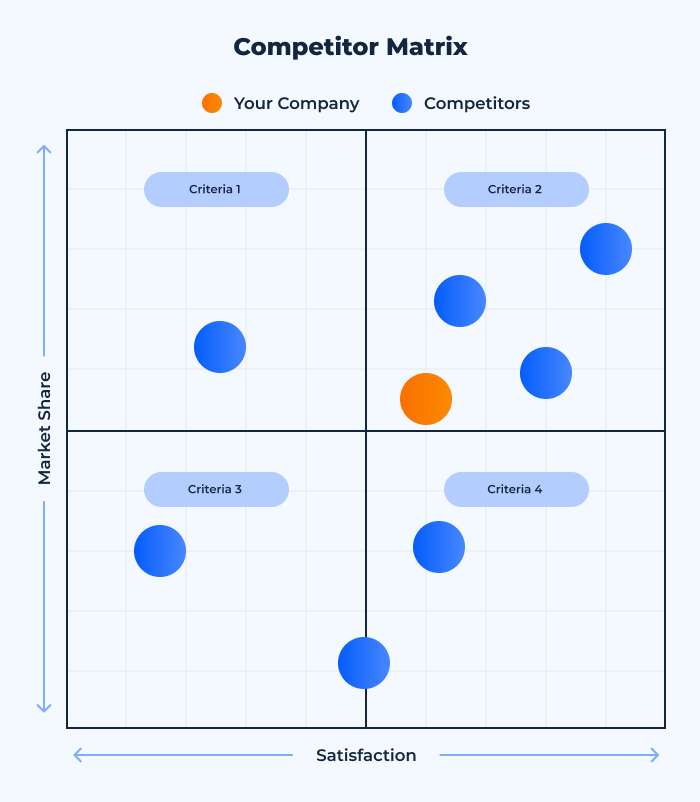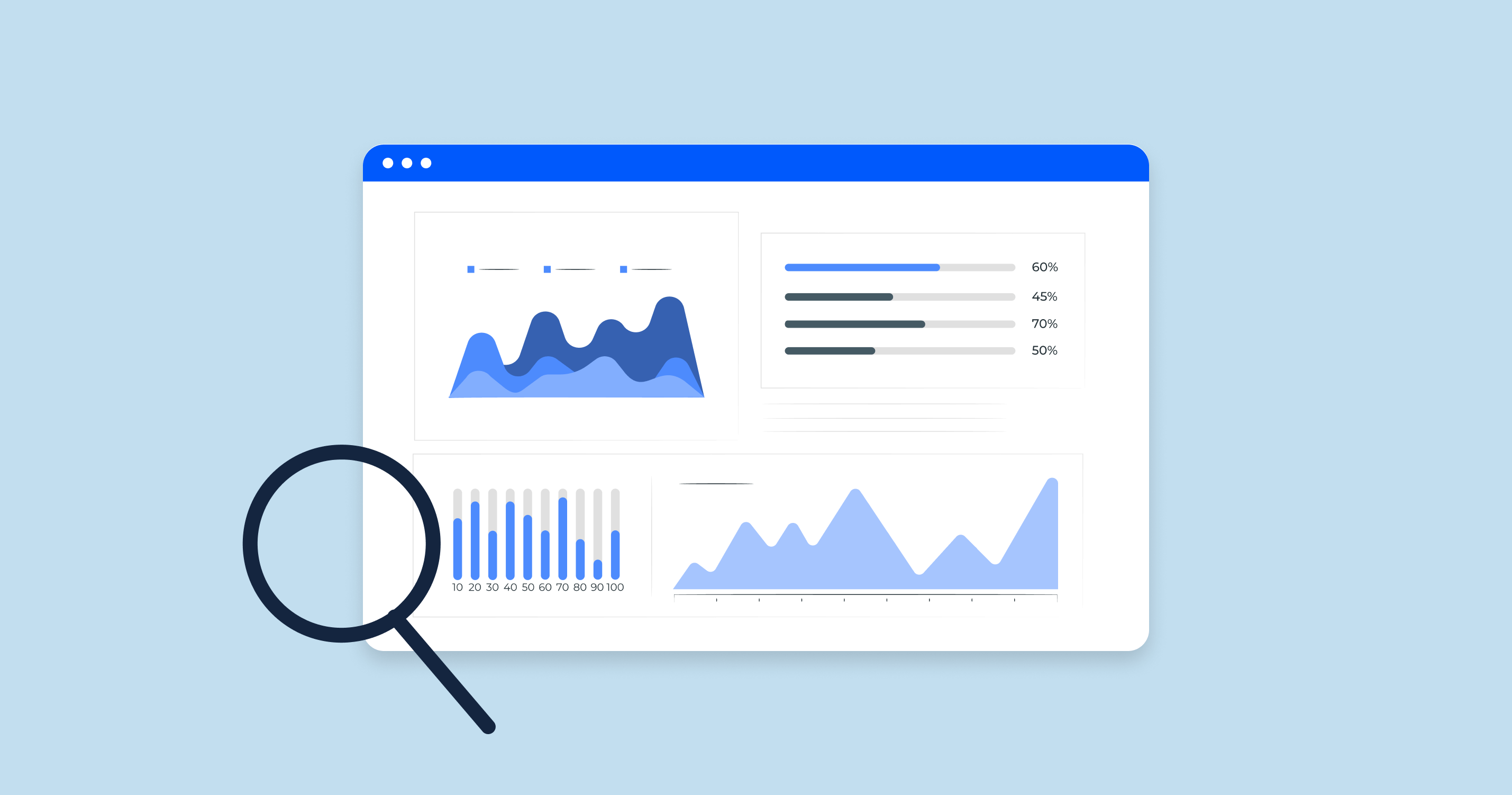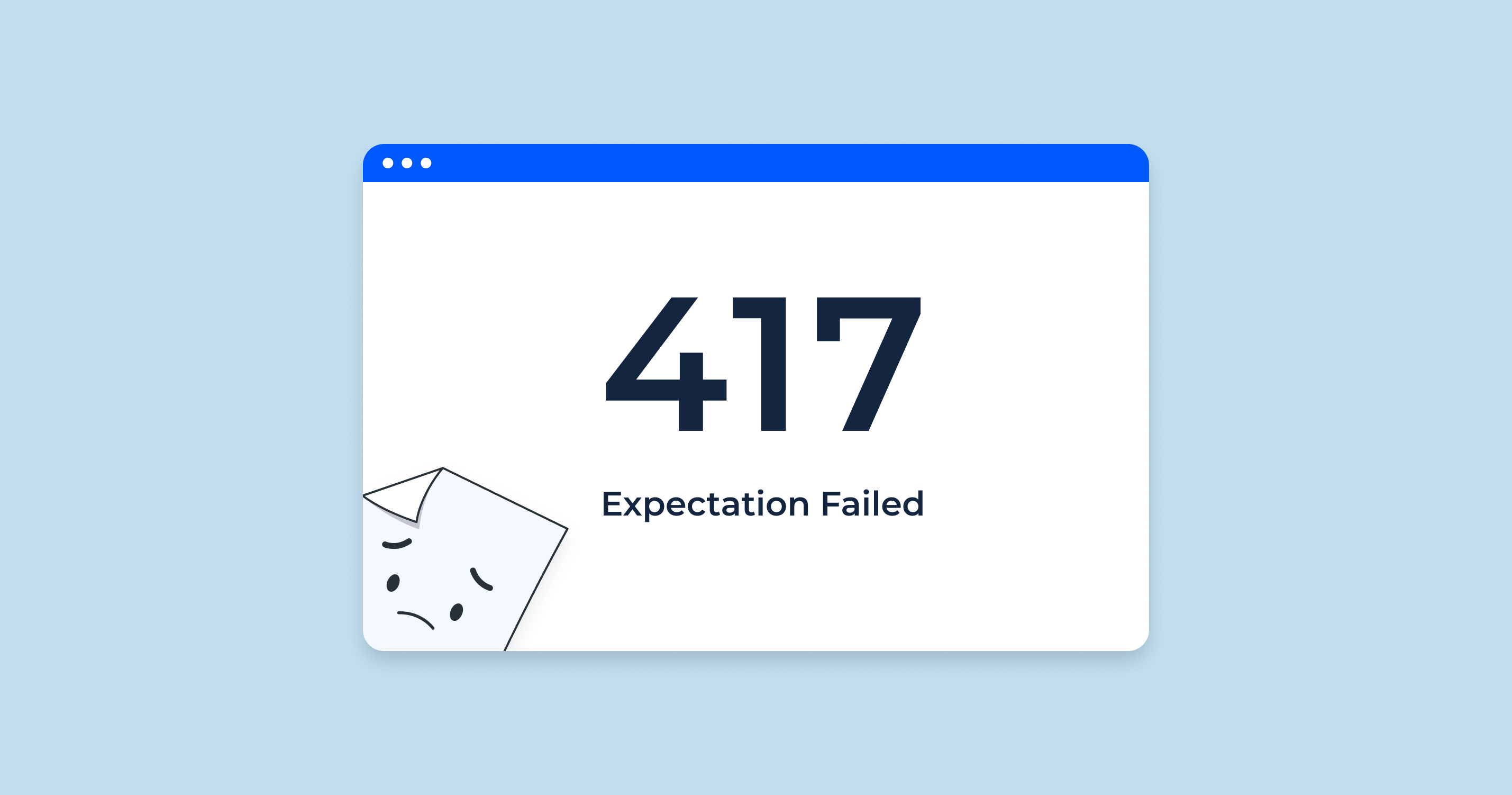What is a Competitor Analysis?
A competitor analysis, often referred to as competitive analysis, is a strategic assessment where a company identifies and evaluates its main competitors in order to understand their strengths, weaknesses, opportunities, and threats. This analysis can provide insights into the competitive landscape of an industry and help a business understand where it stands in relation to its peers.
Purpose of Competitor Analysis: The primary goal of conducting a competitor analysis is to develop a distinct competitive advantage. By understanding what competitors are doing and identifying gaps in the market, businesses can optimize their strategies, improve their products or services, and better serve their target audience.
Key Elements of Competitor Analysis:
| Identifying Competitors | Before delving deep, it’s crucial to identify who your direct and indirect competitors are. Direct competitors offer similar products or services, while indirect competitors may address the same customer needs but through different means. |
| Analyzing Competitor Offerings | This involves studying competitors’ products, services, pricing strategies, and customer reviews. Understanding their value proposition can help you differentiate your offering. |
| Market Position | Understanding where your competitors position themselves in the market can provide insights into potential market gaps or areas of saturation. |
| Strengths and Weaknesses | Identifying what competitors do well and where they fall short can help you leverage your strengths and address areas where you may be lacking. |
| Marketing and Promotion Strategies | By observing how competitors market themselves, you can gain insights into effective marketing channels, promotional techniques, and customer acquisition strategies. |
| Operational Insights | This includes understanding competitors’ supply chain, distribution channels, and customer support mechanisms. |
Competitor analysis is not just about understanding your competitors but also about understanding yourself. It provides valuable insights that can shape your business strategy, allowing you to navigate the competitive landscape effectively and carve out a unique position in the market.
Why Do a Competitor Analysis?
Conducting a competitor analysis is an integral aspect of strategic planning for businesses. It offers a clear picture of the competitive landscape and provides actionable insights that can drive decision-making and foster growth. Here are some compelling reasons why businesses should invest time and resources into a thorough competitor analysis:
Identify your business’s strengths and weaknesses
- Overview: One of the primary benefits of a competitor analysis is that it allows businesses to take an introspective look at their operations, products, and services in comparison to their competitors.
- Strengths: By analyzing the competition, a business can identify what it does better than others. This could be in terms of product quality, customer service, operational efficiency, or any other aspect that gives it an edge.
- Weaknesses: Similarly, understanding where competitors excel can shed light on areas where a business might be lagging. Recognizing these weaknesses early on can help in addressing them before they become significant issues.
Understand your market
- Overview: A thorough competitor analysis goes beyond just looking at competitors—it provides a holistic view of the market.
- Customer Preferences: By studying competitors, businesses can gain insights into what customers in the market value, their preferences, and their pain points.
- Market Segmentation: It also offers a clearer picture of the different segments within the market, helping businesses tailor their strategies accordingly.
Spot industry trends
- Overview: Industries are constantly evolving, with new trends and technologies emerging regularly. A competitor analysis can help businesses stay ahead of the curve.
- Innovation: By observing competitors, businesses can identify innovative practices, products, or technologies they are adopting.
- Changing Dynamics: It also helps in recognizing shifts in industry dynamics, be it in terms of consumer behavior, regulatory changes, or technological advancements.
Set benchmarks for future growth
- Overview: Competitor analysis can serve as a benchmarking tool, helping businesses set realistic and achievable goals for the future.
- Performance Metrics: By comparing key performance metrics with competitors, businesses can set clear targets for themselves in areas like sales, customer acquisition, and operational efficiency.
- Strategic Planning: Understanding where competitors are headed in terms of expansion, product launches, or strategic partnerships can help businesses plan their future moves more effectively.
In summary, a competitor analysis is not just about understanding the competition—it’s about refining one’s strategy, identifying areas of improvement, and ensuring that a business is well-positioned to navigate challenges and seize opportunities in the ever-evolving market landscape.
How to Identify Your Competitors
In today’s competitive business landscape, understanding who your competitors are is crucial. It allows you to gauge the competitive intensity, identify market gaps, and strategize effectively. Here’s a comprehensive guide on identifying various types of competitors:
Direct competitors
- Overview: Direct competitors are businesses that offer similar products or services and target the same customer base within the same geographic region.
-
Identification Methods:
- Market Research: Conduct surveys or interviews with customers to identify brands or businesses they consider while making purchase decisions.
- Industry Reports: Industry-specific reports often list leading players and emerging challengers.
- Online Marketplaces: Browse platforms like Amazon or eBay to identify brands offering similar products.
Indirect competitors
- Overview: Indirect competitors offer different products or services but cater to the same customer needs or problems.
-
Identification Methods:
- Customer Feedback: Engage with customers to understand alternative solutions they consider.
- Cross-industry Analysis: Analyze industries that might offer alternative solutions to the same customer problems.
Replacement competitors
- Overview: Replacement competitors offer products or services that can be substituted for yours, even if they cater to different needs.
-
Identification Methods:
- Substitution Threat Analysis: Identify products or services that customers might opt for in the absence of your offering.
- Market Dynamics: Monitor market shifts to see if new replacements emerge due to technological advancements or changing consumer preferences.
Finding Your Industry Competitors
- Overview: These are businesses operating within your specific industry vertical.
-
Identification Methods:
- Trade Associations: Attend industry events or conferences and review member directories.
- Industry Publications: Magazines or online portals often profile industry players.
Finding Your Organic Competitors
- Overview: Organic competitors are businesses that compete for the same set of keywords in search engine results without paid advertisements.
-
Identification Methods:
-
SEO Tools: Use tools like Sitechecker to identify domains ranking for the same keywords as your website.

- Google Search: Input industry-specific keywords into search engines and note the businesses appearing in the results.
-
SEO Tools: Use tools like Sitechecker to identify domains ranking for the same keywords as your website.
Finding Your Paid Search Competitors
- Overview: These competitors bid on the same keywords as you in search engine advertising platforms like Google Ads.
-
Identification Methods:
- Ad Monitoring Tools: Platforms like SpyFu or AdEspresso allow you to see which businesses are bidding on specific keywords.
- Manual Search: Conduct regular searches for high-value keywords and observe the sponsored results.
Finding Local SEO Competitors
- Overview: These are businesses competing for visibility in local search results, crucial for businesses with physical locations or those serving specific localities.
-
Identification Methods:
-
Google Maps: Search for industry-specific terms in your location on Google Maps.

-
Local Directories: Browse local business directories or review sites like Yelp or Yellow Pages.

-
Google Maps: Search for industry-specific terms in your location on Google Maps.
In conclusion, identifying competitors is a multi-faceted process. By understanding the different types of competitors and leveraging various tools and techniques, businesses can get a comprehensive view of the competitive landscape and strategize accordingly.
Google About a Competitor Analysis
John Mueller, a Webmaster Trends Analyst at Google, has spoken about competitor analysis on Twitter on a number of occasions. He has advised against copying the SEO strategies of competitors, especially if those strategies are spammy or unethical. He has also emphasized that word count is not a ranking factor, and that it is more important to focus on creating comprehensive and informative content.
Here are some specific examples of what John Mueller has said about competitor analysis on Twitter:
-
On copying competitor SEO strategies:
"No need to copy their bad practices, when you know better!" (in response to a tweet about a competitor using thin content to rank well) -
On the importance of creating comprehensive content:
Google does not have a minimum word count requirement for content. However, we do want to make sure that the content is comprehensive and informative, and that it meets the needs of the user. -
On the importance of avoiding spammy tactics:
We don't recommend trying to game the system. It's better to focus on creating high-quality content that people will find useful.
Overall, John Mueller’s advice on competitor analysis is to focus on improving your own website and creating high-quality content, rather than trying to copy the strategies of your competitors. He has also emphasized that it is important to avoid spammy tactics and to focus on meeting the needs of your users.
How to Research Your Competitors’ Strategies
Competitive research is a cornerstone of successful business strategy. By understanding how competitors operate and what they offer, companies can identify gaps, leverage strengths, and counteract potential threats. Here’s how to dive deep into researching your competitors’ strategies:
Focus on the 4 P’s
The 4 P’s of marketing (Product, Price, Promotion, and Place) are foundational elements that define a company’s marketing mix. By analyzing each of these elements for your competitors, you can gain comprehensive insights into their strategies.
Product
- Overview: Understand the range, quality, features, and benefits of competitors’ products or services.
-
Research Methods:
- Customer Reviews: Platforms like Amazon, Yelp, or Trustpilot can offer insights into product strengths and weaknesses.
- Product Trials: If feasible, purchase and use the competitor’s product to gain firsthand experience.
- Feature Comparison: Create a comparison chart to evaluate product features side by side.
Price
- Overview: Analyze the pricing strategies, discount structures, and value propositions of competitors.
-
Research Methods:
- Website Analysis: Many companies list prices or pricing structures on their websites.
- Secret Shopping: Pose as a potential customer to inquire about prices, discounts, or financing options.
- Industry Reports: Some industry publications provide insights into average pricing or market rates.
Promotion
- Overview: Understand how competitors are promoting their products—advertising channels, promotional offers, marketing campaigns, etc.
- Research Methods:
- Ad Monitoring Tools: Platforms like AdSpy or Moat can show you competitors’ digital ads.
- Social Media Analysis: Analyze competitors’ social media channels to observe promotional campaigns, frequency, and engagement.
- Email Subscriptions: Subscribe to competitors’ newsletters to monitor promotional offers and content strategies.
Place
- Overview: Identify where competitors are selling their products—online platforms, physical stores, third-party retailers, etc.
-
Research Methods:
- Website Analysis: Check if competitors offer online shopping, store locators, or details on distribution channels.
- Market Surveys: Conduct surveys to understand where customers typically purchase these products.
- Industry Publications: Some reports might offer insights into distribution strategies or market presence.
Create Competitor Profiles
Creating detailed profiles for each major competitor can help in organizing the gathered information and drawing actionable insights.
Analyzing Market Share
- Overview: Understand the portion of the market controlled by each competitor.
-
Research Methods:
- Industry Reports: Many industry-specific reports provide market share data.
- Sales Data: If accessible, sales figures can provide insights into market dominance.
- Customer Surveys: Ask customers about their preferred brands or products in the category.
Understanding Audience Demographics
- Overview: Gain insights into the typical customers of your competitors—age, gender, location, preferences, etc.
-
Research Methods:
- Social Media Insights: Platforms like Facebook offer audience insights for pages.
- Customer Reviews: Reviews can sometimes provide demographic clues based on the language, concerns, or praises mentioned.
- Survey Data: Conducting surveys or accessing third-party survey results can yield demographic information.
Researching competitors’ strategies requires a mix of observational research, analytical tools, and sometimes, a bit of detective work. By systematically breaking down the research process and focusing on key elements, businesses can gain invaluable insights to inform their own strategies.
How to Conduct a Comprehensive Competitor Analysis
Conducting a thorough competitor analysis requires a structured approach to gather, organize, and interpret information about your competition. This comprehensive analysis will equip you with actionable insights to inform your business strategy. Here’s a step-by-step guide:
Create a competitor matrix

- Overview: A competitor matrix is a tool that allows you to visually compare and contrast your company’s offerings against those of your competitors.
-
How-To:
- List Competitors: Begin by listing down your main competitors.
- Define Criteria: Determine the criteria for comparison, such as product features, pricing, market share, customer reviews, etc.
- Fill the Matrix: For each competitor and criterion, provide relevant information.
- Analyze & Interpret: Look for patterns, gaps, or standout features that might indicate competitive advantages or areas of improvement.
Gather background information
Understanding the backdrop against which your competitors operate can provide context to their strategies and decisions.
Company history
- Overview: Delve into the origins, milestones, and evolution of the competitor companies.
-
Research Methods:
- Company Websites: Most companies have an ‘About Us’ section detailing their history.
- Business Databases: Platforms like Crunchbase or Bloomberg provide company histories and major milestones.
Location
- Overview: Understand where competitors are headquartered, where they operate, and where they have a significant presence.
-
Research Methods:
- Company Websites: Locations are often listed on contact pages or about sections.
- Google Maps: Search for competitor names to find their locations.
Company size
- Overview: Gauge the scale of your competitors in terms of employees, revenue, and market presence.
-
Research Methods:
- Business Databases: Platforms like LinkedIn or Glassdoor can provide estimates on employee numbers.
- Annual Reports: For publicly traded companies, annual reports provide detailed financials.
Profile your competition’s target customers
- Overview: Understand who your competitors are targeting in terms of demographics, preferences, and behaviors.
-
Research Methods:
- Customer Reviews: Analyze feedback to understand who is using competitors’ products or services.
- Social Media Analysis: Look at followers, engagement patterns, and content themes on competitors’ social media profiles.
- Surveys: Conduct or access third-party surveys to get insights into target customer profiles.
Identify Your Strengths, Weaknesses, Opportunities & Threats (SWOT Analysis)
- Overview: SWOT Analysis is a strategic tool that helps businesses identify internal strengths and weaknesses, as well as external opportunities and threats.
-
How-To:
- Internal Analysis: Evaluate your company’s internal environment to identify strengths and weaknesses.
- External Analysis: Look at the external environment, including market trends, competitor strategies, and industry changes, to spot opportunities and threats.
Analyze strengths and weaknesses—yours and your competitors’
- Overview: Dive deeper into what both you and your competitors do well and where there are gaps.
-
Research Methods:
- Customer Feedback: Listen to your customers and also monitor feedback on competitor products.
- Product Comparisons: Conduct hands-on comparisons of products or services to identify features or quality differences.
- Service Evaluation: Analyze the level of customer service, after-sales support, and other service-related parameters.
Comprehensive competitor analysis is a meticulous process but is invaluable for businesses aiming to navigate the competitive landscape effectively. By following this structured approach, businesses can gain deep insights, inform their strategies, and position themselves for success.
A Competitor Analysis Sets You Up for Success
Competitor analysis is more than just a cursory look at what other businesses in your industry are doing; it’s a strategic process that can position a company for growth, innovation, and long-term success. Here’s how and why a well-executed competitor analysis can be a game-changer for businesses:
- Informed Decision Making:
- Overview: At its core, competitor analysis provides a wealth of information that can guide key business decisions.
- Benefits: Whether it’s entering a new market, launching a product, or rebranding, having insights into competitors’ actions and market dynamics ensures decisions are data-driven and not based on assumptions.
- Identifying Market Gaps:
- Overview: One of the primary goals of competitor analysis is to find unmet needs or areas underserved by competitors.
- Benefits: By identifying these gaps, businesses can tailor their offerings, create niche products, or refine their services to address specific customer needs, giving them a competitive edge.
- Mitigating Risks:
- Overview: Understanding the competitive landscape allows businesses to foresee potential challenges and threats.
- Benefits: Whether it’s a disruptive technology, a new market entrant, or changing consumer preferences, being aware allows businesses to adapt and pivot, reducing potential risks.
- Strengthening Your Value Proposition:
- Overview: By analyzing competitors, businesses can understand the unique selling points and differentiators that resonate with their target audience.
- Benefits: This knowledge enables companies to emphasize and build upon their strengths, crafting a compelling value proposition that attracts and retains customers.
- Driving Innovation:
- Overview: Observing competitors can often inspire innovation.
- Benefits: Whether it’s enhancing a product feature, adopting a new technology, or reimagining a process, insights from competitor analysis can spur creative thinking and drive innovation.
- Resource Allocation:
- Overview: Competitor analysis provides insights into areas that promise the highest return on investment.
- Benefits: Whether it’s marketing spend, research and development, or customer service enhancements, understanding where competitors are gaining traction can guide resource allocation, ensuring efforts are directed towards the most impactful areas.
- Building and Maintaining Brand Reputation:
- Overview: In today’s digital age, brand reputation is paramount. Understanding how competitors manage their brand can offer valuable lessons.
- Benefits: Whether it’s exceptional customer service, ethical practices, or community involvement, competitor analysis can highlight reputation-building strategies that resonate with customers.
Сompetitor analysis is not just a tactical exercise; it’s a strategic necessity. By systematically studying the competition, businesses can stay ahead of the curve, make informed decisions, and set themselves up for sustained success in an ever-evolving marketplace.
Check & Track Website Inbound Links with Backlink Checker & Tracker
The Backlink Checker & Tracker by SiteChecker is a vital tool for SEO experts and website owners aiming to enhance their site’s search engine performance. This tool comprehensively analyzes a site’s backlink profile, offering insights into the quality, quantity, and sources of backlinks. It’s particularly useful for identifying and monitoring backlinks that contribute to a website’s domain authority and search ranking. In today’s digital landscape, where robust backlink profiles are crucial for SEO success, this tool provides the necessary data to understand and improve a website’s backlink strategy.
Apart from just listing backlinks, this tool delves deeper by evaluating the relevance and authority of the linking domains and the context of the backlinks. This helps in distinguishing between high-quality backlinks that positively impact SEO and low-quality links that might harm it. Additionally, the Backlink Checker & Tracker keeps track of new and lost backlinks, enabling users to react promptly to any significant changes in their backlink profile. This feature is essential for maintaining a healthy and effective backlink strategy, making this tool indispensable for ongoing SEO management and strategy development.
Monitor Your Backlinks Now!
Enhance your SEO with detailed backlink analysis.
Conclusion
Competitor analysis stands as a pivotal element in strategic business planning. It equips companies with the insights they need to navigate the ever-evolving business landscape, identify opportunities, and mitigate potential risks. By understanding the strengths and weaknesses of both their own operations and those of their competitors, businesses can carve out a unique market position, drive innovation, and set the stage for sustained success. In a world where change is the only constant, a thorough competitor analysis ensures businesses remain agile, informed, and ahead of the curve.






![How to Hire an SEO Specialist [Questions to Ask Included] How to Hire an SEO Specialist [Questions to Ask Included]](https://sitechecker.pro/wp-content/uploads/2020/11/How-to-Hire-an-SEO-Specialist-.png)

